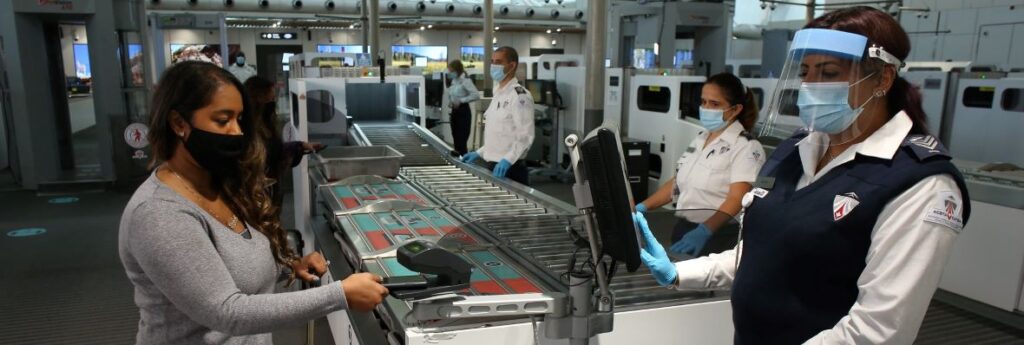With the busy spring travel season upon us and summer looming, the decision to cap flights and the number of travellers by the Greater Toronto Airports Authority (GTAA) last week fails both passengers and airport workers, says the union representing the latter.
“The GTAA is punishing the travelling public by limiting flights and services as a band-aid solution to airport congestion, instead of fixing the problem by implementing common sense solutions to improve job quality and hire needed workers,” says Unifor national president Lana Payne.
“We need to end the chaos in airports – but a travel cap merely limits supply instead of meeting the demand. At the core of things, this is a failure to keep the aviation industry attractive to workers.”
Unifor has repeatedly called on the aviation industry to change its failing workforce strategies by ending the practice of contract flipping and paying airport workers a living wage.
The GTAA first announced the caps in August 2022 as a stop gap measure to limit baggage handling and security screening needs during peak times.
“Seeing that the plan hasn’t evolved since first announced last summer, shows just how little effort government and industry are putting into solving the underlying problems.” says Payne. “These measures just contribute to angry and frustrated travellers. Putting on a cap today isn’t relieving the pressure for air travel tomorrow.”
Unifor says it has provided recommendations to airlines, airports, and the federal government consistently over the years, adding that the problems facing the industry are not new but were exacerbated by decisions made during the pandemic to treat the workforce as “disposable instead of with respect for the work they do.”
The union wants the federal government to require a minimum living wage at Canada’s airports, which would be $23.15 at Toronto Pearson, end the “worst effects” of contract flipping by implementing full successor rights, limit the number of ground handling companies that can operate at the airport, and develop a solution to the escalating problem of on-the job-harassment.
Unifor also maintains that employers have been relying on extensive and unfilled overtime to avoid hiring, putting higher demands, in particular, on the remaining air traffic controllers.
“The effects of operating with no resilience in the system have resulted in chaos and now a limit on supply,” said Payne. “Surely, the industry can do better.”
Airlines and the two federal agencies responsible for airport security screeners and border officers, say they are adequately staffed to handle the flood of spring travellers, though some hedged their confidence.
“While we are well staffed and prepared for the spring and summer travel seasons, it’s important to note that wait times at any airport can occur for various reasons, even when staffing levels are optimal, and can fluctuate throughout the day based on passenger volume/number of flights,” said Suzanne Perseo, a spokeswoman for the Canadian Air Transport Security Authority (CATSA), in an email.
She said the agency has about 172 more screening officers and recruits than in 2019, when it employed 8,284 screeners. At the country’s four largest airports – Toronto, Montreal, Vancouver, and Calgary – staffing levels are at or above pre-pandemic levels, she said.
Air Canada boasted a head count of about 37,000 at the end of February compared with 35,680 in December and just over 31,000 a year ago.
“The Canadian job market is very competitive so attracting and retaining talent is a challenge for all companies,” said airline spokesman Peter Fitzpatrick.
Flair Airlines CEO Stephen Jones said last week that staff turnover is one of the biggest hurdles in an industry that requires substantial training and skills across much of its workforce, from flight crews to air traffic controllers.
“Pilots are heavily in demand, and mobile… The other part really is the airport labour force, whether it’s the baggage handlers or check-in – not so much attracting people necessarily, but the level of attrition,” he said at a press conference.
“Mechanics are another that’s very much in demand – the maintenance engineers” – who typically need a four-year college diploma or apprenticeship program as well as several years of on-the-job training.
Customer service agents receive “abysmal” training and unsustainable schedules at some airlines, said Leslie Dias, director of airlines at Unifor, which represents nearly 9,000 agents.
“We have some airline workers whose entire training happens virtually. They never even step into an airport until essentially their first day of work. So, I think you can imagine what that means in terms of assisting passengers,” she said.
“And you can have a shift that’s from 3 a.m. to 7 a.m. or some crazy time that’s late at night. And they’re not always stable hours” – resulting in further turnover – she said.
Security screeners’ attrition rate in the three months between July and September was about 10% countrywide, though it’s “trending down,” CATSA said.
David Lipton, a spokesman for the United Steelworkers union that represents some 2,000 screeners across 44 Canadian airports, partly agreed, pointing to wage hikes in recent collective agreements: “The situation is still difficult in terms of retention and recruiting, but it is improving.”
The number of scheduled flights by Air Canada and WestJet jumped 31% to 47,362 this month from 36,062 in the same period a year earlier, according to flight data firm Cirium.

